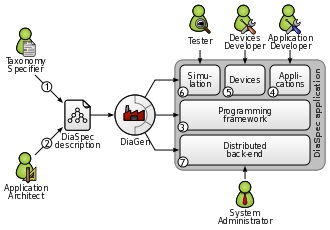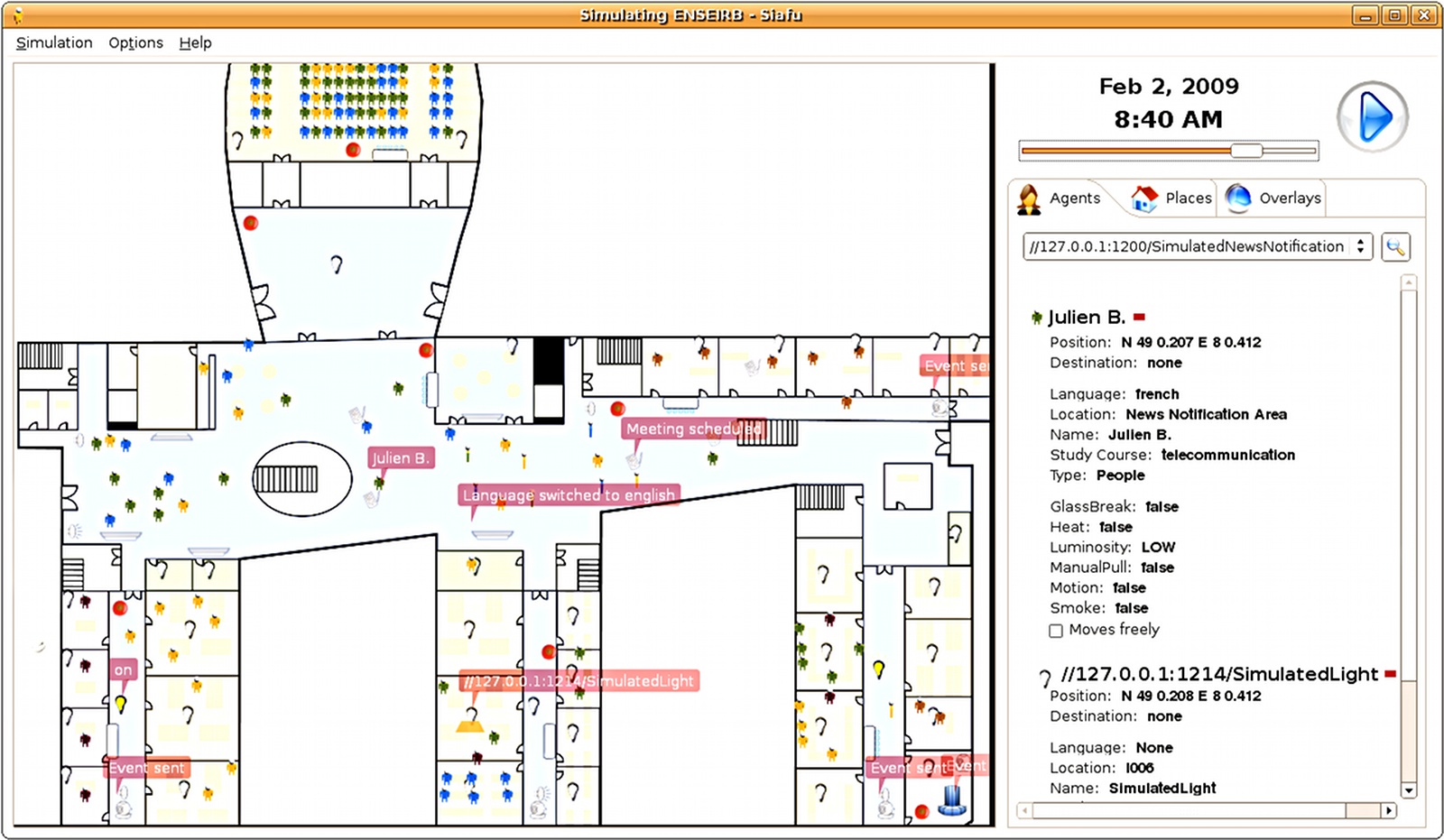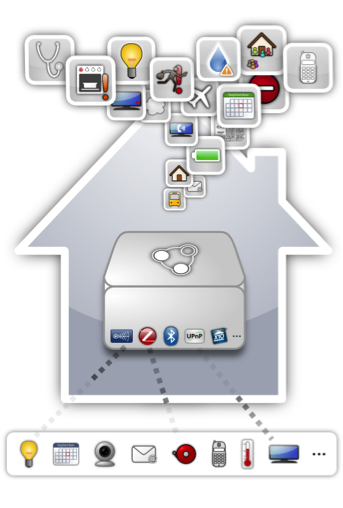Despite much progress, developing a pervasive computing application remains a challenge because of a lack of conceptual frameworks and supporting tools. This challenge involves coping with heterogeneous devices, overcoming the intricacies of distributed systems technologies, working out an architecture for the application, encoding it in a program, writing specific code to test the application, and finally deploying it.
A Tool-based Development Methodology
DiaSuite is a suite of tools covering the development life-cycle of a pervasive computing application:
- Defining an application area. First, an expert defines a catalog of entities, whether hardware or software, that are specific to a target area. These entities serve as building blocks to develop applications in this area. They are gathered in a taxonomy definition, written in the taxonomy layer of the DiaSpec language.
- Designing an application. Given a taxonomy, the architect can design and structure applications. To do so, the DiaSpec language provides an application design layer. This layer is dedicated to an architectural pattern commonly used in the pervasive computing domain. Describing the architecture application allows to further model a pervasive computing system, making explicit its functional decomposition.
- Implementing an application. We leverage the taxonomy definition and the architecture description to provide dedicated support to both the entity and the application developers. This support takes the form of a Java programming framework, generated by the DiaGen compiler. The generated programming framework precisely guides the developer with respect to the taxonomy definition and the architecture description. It consists of high-level operations to discover entities and interact with both entities and application components. In doing so, it abstracts away from the underlying distributed technologies, providing further separation of concerns.
- Testing an application.DiaGen generates a simulation support to test pervasive computing applications before their actual deployment. An application is simulated in the DiaSim tool, without requiring any code modification. DiaSim provides an editor to define simulation scenarios and a 2D-renderer to monitor the simulated application. Furthermore, simulated and actual entities can be mixed. This hybrid simulation enables an application to migrate incrementally to an actual environment.
- Deploying a system. Finally, the system administrator deploys the pervasive computing system. To this end, a distributed systems technology is selected. We have developed a back-end that currently targets the following technologies: Web Services, RMI, SIP and OSGI. This targeting is transparent for the application code. The variety of these target technologies demonstrates that our development approach separates concerns into well-defined layers.
This development cycle is summarized below.

DiaSpec: a Domain-Specific Language for Networked Entities
The core of the DiaSuite development environment is the domain specific language called DiaSpec and its compiler DiaGen.
A Two-Level Design Language
DiaSpec is composed of two layers.
- The Taxonomy Layer allows the declaration of entities that are relevant to the target application area. An entity consists of sensing capabilities, producing data, and actuating capabilities, providing actions. Accordingly, an entity description declares a data source for each one of its sensing capabilities. As well, an actuating capability corresponds to a set of method declarations. An entity declaration also includes attributes, characterizing properties of entity instances. Entity declarations are organized hierarchically allowing entity classes to inherit attributes, sources and actions. A taxonomy allows separation of concerns in that the expert can focus on the concerns of cataloging area-specific entities. The entity developer is concerned about mapping a taxonomical description into an actual entity, and the application developer concentrates on the application logic.
- The Architecture Layer is based on an architectural pattern commonly used in the pervasive computing domain. It consists of context components fueled by sensing entities. These components process gathered data to make them amenable to the application needs. Context data are then passed to controller components that trigger actions on entities. Using an architecture description enables the key components of an application to be identified, allowing their implementation to evolve with the requirements (e.g., varying light management implementations in a controller component to optimize energy consumption).
The DiaSpec Compiler
DiaGen is the DiaSpec compiler that performs both static and runtime verifications over DiaSpec declarations and produces a dedicated programming framework that guides and eases the implementation of components. The generated framework is independent of the underlying distributed technology. As of today, DiaGen supports multiple targets: Local, RMI, SIP, Web Services and OSGI.
DiaSim: a Parametrized Simulator for Pervasive Computing Applications
Pervasive computing applications involve both software and integration concerns. This situation is problematic for testing pervasive computing applications because it requires acquiring, testing and interfacing a variety of software and hardware entities. This process can rapidly become costly and time-consuming when the target environment involves many entities. To ease the testing of pervasive applications, we are developing a simulator for pervasive computing applications: DiaSim. To cope with widely heterogeneous entities, DiaSim is parameterized with respect to a DiaSpec specification describing a target pervasive computing environment. This description is used to generate with DiaGen both a programming framework to develop the simulation logic and an emulation layer to execute applications. Furthermore, a simulation renderer is coupled to DiaSim to allow a simulated pervasive system to be visually monitored and debugged. The simulation renderer is illustrated below.

DiaSuiteBox: an Open Orchestration Platform
The DiaSuiteBox platform runs an open-ended set of applications leveraging a range of appliances and web services. Our solution consists of a dedicated development environment, a certifying application store, and a lightweight runtime platform. This solution is based on the DiaSuite project.
The DiaSuiteBox platform can be embedded in a small plug-computer or deployed in the cloud. Thanks to the application store and the developer community, the platform is fed by a full offer of new innovative applications. During the submission process, an application is automatically analyzed and checked in order to be certified. The user is ensured the behavior of its applications are innocuous and correct with respect to the provided information. Finally, DiaSuiteBox provides an extensible software architecture. This allows the easily connect new device technologies to the platform. For example, the support for new wireless communication technologies such as Zigbee, Z-Wave or Sigfox can be easily added to the DiaSuiteBox platform.

The DiaSuite manual can be found here.
Contributors
Artefacts
- Source code for prototypes: DiaRacket, Android prototypes.
Publications
2017
Journal articles
- titre
- Designing Parallel Data Processing for Enabling Large-Scale Sensor Applications
- auteur
- Milan Kabáč, Charles Consel, Nic Volanschi
- article
- Personal and Ubiquitous Computing, Springer Verlag, 2017, 21 (3), pp.457-473. ⟨10.1007/s00779-017-1009-1⟩
- Accès au texte intégral et bibtex
-


2016
Conference papers
- titre
- Designing Parallel Data Processing for Large-Scale Sensor Orchestration
- auteur
- Milan Kabáč, Charles Consel
- article
- 13th IEEE International Conference on Ubiquitous Intelligence and Computing (UIC 2016), Jul 2016, Toulouse, France
- Accès au texte intégral et bibtex
-


- titre
- Leveraging Declarations over the Lifecycle of Large-Scale Sensor Applications
- auteur
- Milan Kabáč, Charles Consel, Nic Volanschi
- article
- 13th IEEE International Conference on Ubiquitous Intelligence and Computing (UIC 2016), Jul 2016, Toulouse, France
- Accès au texte intégral et bibtex
-


2015
Conference papers
- titre
- Orchestrating Masses of Sensors: A Design-Driven Development Approach
- auteur
- Milan Kabáč, Charles Consel
- article
- 14th International Conference on Generative Programming: Concepts & Experience (GPCE'15), Oct 2015, Pittsburgh, Pennsylvania, United States. ⟨10.1145/2814204.2814226⟩
- Accès au texte intégral et bibtex
-


2014
Journal articles
- titre
- DiaSuite: a Tool Suite To Develop Sense/Compute/Control Applications
- auteur
- Benjamin Bertran, Julien Bruneau, Damien Cassou, Nicolas Loriant, Emilie Balland, Charles Consel
- article
- Science of Computer Programming, Fourth special issue on Experimental Software and Toolkits, Elsevier, 2014, Science of Computer Programming, 79, ⟨10.1016/j.scico.2012.04.001⟩
- Accès au texte intégral et bibtex
-


2013
Journal articles
- titre
- DiaSim: A Simulator for Pervasive Computing Applications
- auteur
- Julien Bruneau, Charles Consel
- article
- Software: Practice and Experience, Wiley, 2013, 43 (8), ⟨10.1002/spe.2130⟩
- Accès au texte intégral et bibtex
-


Conference papers
- titre
- A Case for Human-Driven Software Development
- auteur
- Emilie Balland, Charles Consel, Bernard N'Kaoua, Hélène Sauzeon
- article
- ICSE'13: Proceedings of the 35th International Conference on Software Engineering (NIER track), May 2013, San Francisco, United States
- Accès au texte intégral et bibtex
-


- titre
- Design-Driven Development Methodology for Resilient Computing
- auteur
- Quentin Enard, Miruna Stoicescu, Emilie Balland, Charles Consel, Laurence Duchien, Jean-Charles Fabre, Matthieu Roy
- article
- CBSE'13: Proceedings of the 16th International ACM Sigsoft Symposium on Component-Based Software Engineering, Jun 2013, Vancouver, Canada
- Accès au texte intégral et bibtex
-


- titre
- Design-driven Development of Dependable Applications: A Case Study in Avionics
- auteur
- Quentin Enard, Stéphanie Gatti, Julien Bruneau, Young-Joo Moon, Emilie Balland, Charles Consel
- article
- PECCS - 3rd International Conference on Pervasive and Embedded Computing and Communication Systems, Feb 2013, Barcelona, Spain
- Accès au texte intégral et bibtex
-


2012
Journal articles
- titre
- Towards a Tool-based Development Methodology for Pervasive Computing Applications
- auteur
- Damien Cassou, Julien Bruneau, Charles Consel, Emilie Balland
- article
- IEEE Transactions on Software Engineering, Institute of Electrical and Electronics Engineers, 2012, 38 (6), pp.1445-1463. ⟨10.1109/TSE.2011.107⟩
- Accès au texte intégral et bibtex
-


Conference papers
- titre
- Virtual Testing for Smart Buildings
- auteur
- Julien Bruneau, Charles Consel, Marcia O'Malley, Walid Taha, Wail Masry Hannourah
- article
- IE 2012 - 8th International Conference on Intelligent Environments, Jun 2012, Guanajuato, Mexico
- Accès au texte intégral et bibtex
-


- titre
- An Experimental Study of A Design-driven, Tool-based Development Approach
- auteur
- Quentin Enard, Christine Louberry, Charles Consel, Xavier Blanc
- article
- User Evaluation for Software Engineering Researchers (USER), 2012, Zurich, Switzerland. ⟨10.1109/USER.2012.6226581⟩
- Accès au texte intégral et bibtex
-


2011
Conference papers
- titre
- DiaSuite:A Paradigm-Oriented Software Development Approach (invited paper)
- auteur
- Charles Consel
- article
- 20th ACM SIGPLAN workshop on Partial evaluation and program manipulation : PEPM'11, Jan 2011, Austin, TX, United States. pp.77-78, ⟨10.1145/1929501.1929515⟩
- Accès au texte intégral et bibtex
-


- titre
- A Step-wise Approach for Integrating QoS throughout Software Development
- auteur
- Stéphanie Gatti, Emilie Balland, Charles Consel
- article
- FASE'11: Proceedings of the 14th European Conference on Fundamental Approaches to Software Engineering, Mar 2011, Sarrebruck, Germany. pp.217-231
- Accès au texte intégral et bibtex
-


- titre
- Leveraging Software Architectures to Guide and Verify the Development of Sense/Compute/Control Applications
- auteur
- Damien Cassou, Emilie Balland, Charles Consel, Julia Lawall
- article
- ICSE'11 - 33rd International Conference on Software Engineering, May 2011, Honolulu, HI, United States. pp.431-440, ⟨10.1145/1985793.1985852⟩
- Accès au texte intégral et bibtex
-


Reports
- titre
- Design-driven Development of Safety-critical Applications: A Case Study In Avionics
- auteur
- Julien Bruneau, Quentin Enard, Stéphanie Gatti, Emilie Balland, Charles Consel
- article
- [Technical Report] 2011
- Accès au texte intégral et bibtex
-


2010
Conference papers
- titre
- SIP as a Universal Communication Bus: A Methodology and an Experimental Study
- auteur
- Benjamin Bertran, Charles Consel, Wilfried Jouve, Hongyu Guan, Patrice Kadionik
- article
- International Conference on Communications, May 2010, Cape Town, South Africa. ⟨10.1109/ICC.2010.5502591⟩
- Accès au texte intégral et bibtex
-


- titre
- A Visual, Open-Ended Approach to Prototyping Ubiquitous Computing Applications
- auteur
- Zoé Drey, Charles Consel
- article
- Proceedings of the 8th IEEE Conference on Pervasive Computing and Communications (PERCOM'10), Mar 2010, Mannheim, Germany
- Accès au texte intégral et bibtex
-


- titre
- Open Platforms: New Challenges for Software Engineering
- auteur
- Emilie Balland, Charles Consel
- article
- PSIEtA'10: Proceedings of the International Workshop on Programming Support Innovations for Emerging Distributed Applications, Oct 2010, Reno, United States
- Accès au texte intégral et bibtex
-


- titre
- A Domain-Specific Approach to Architecturing Error Handling in Pervasive Computing
- auteur
- Julien Mercadal, Quentin Enard, Charles Consel, Nicolas Loriant
- article
- OOPSLA: Conference on Object Oriented Programming Systems Languages and Applications, Oct 2010, Reno, United States
- Accès au texte intégral et bibtex
-


2009
Conference papers
- titre
- DiaSim: A Parameterized Simulator for Pervasive Computing Applications
- auteur
- Julien Bruneau, Wilfried Jouve, Charles Consel
- article
- 6th International Conference on Mobile and Ubiquitous Systems: Computing, Networking and Services (Mobiquitous'09), Jul 2009, Toronto, Canada
- Accès au texte intégral et bibtex
-


- titre
- A Generative Programming Approach to Developing Pervasive Computing Systems
- auteur
- Damien Cassou, Benjamin Bertran, Nicolas Loriant, Charles Consel
- article
- GPCE '09: Proceedings of the 8th international conference on Generative programming and component engineering, Oct 2009, Denver, CO, United States. pp.137-146
- Accès au texte intégral et bibtex
-


- titre
- DiaSim: A Parameterized Simulator for Pervasive Computing Applications
- auteur
- Wilfried Jouve, Julien Bruneau, Charles Consel
- article
- IEEE International Conference on Pervasive Computing and Communications, 2009 (Demo), Mar 2009, Galveston, United States
- Accès au texte intégral et bibtex
-


Other publications
- titre
- A Parameterized Simulator for Pervasive Computing Applications
- auteur
- Julien Bruneau, Alexandre Blanquart, Nicolas Loriant, Charles Consel
- article
- 2009
- Accès au bibtex
-


